
Captain Jim Marsden is in trouble: his schooner Dolphin disappeared with a million-dollar shipment of gold bullion, and he’s deep in debt. To compound the suspicion, Vorhees, the man Marsden owes, has been murdered, and Marsden was discovered with the body. Before dying, Vorhees gave Marsden a name and a location–“Carter . . . Haunted Harbor”–but it won’t do him any good if he hangs for Vorhees’ murder.


Broken out of jail by his crew and offered a place out of the law’s reach by a businessman friend, Marsden makes for the island of Pua Mate to run the trading post and investigate Haunted Harbor. On the way there, he and his crew rescue an injured doctor and his daughter stranded by a storm. Once on the island, Marsden and his new friend Patricia Harding search for the identity under which Carter hides: is it Dranga, the assistant at the trading post? Or Kane, who operates a gold mine? Or is it . . . well, actually we know right away that it’s Kane, and there really aren’t very many other suspects, but it takes a while for all of this to come to light. In the mean time, in addition to the danger and double-crosses that come from his search for Carter, he attempts to solve the mystery of Haunted Harbor, which the natives fear to approach. Are the two cases related? I think you know the answer to that.

Despite its Pacific island setting, Haunted Harbor is stylistically similar to Zorro’s Black Whip, which would immediately follow the same year. Aside from leads Kane Richmond (Spy Smasher) as Marsden and Kay Aldridge (Perils of Nyoka) as Patricia, it shares a few cast members with the other serial, as well as both directors (Spencer (Gordon) Bennet and Wallace Grissell). Most notably, George J. Lewis, who would play the hero of Zorro’s Black Whip, plays the duplicitous Dranga, a role apparently more typical for him. The most prominent side characters are Marsden’s crewmen and friends Yank (Clancy Cooper) and Tommy (Marshall J. Reed), and Kane/Carter’s chief henchmen, Snell (Bud Geary) and mine foreman Gregg (Kenne Duncan). (In typical serial fashion, Kane/Carter works his evil through his henchmen for as long as possible to keep Marsden from suspecting him: at one point Marsden even turns Gregg over to Kane, believing that the foreman is Carter.)

Stuntmen Dale Van Sickel and Tom Steele also appear in the casts of both films, a sure sign of energetic fisticuffs to come. As in Zorro’s Black Whip, the fight scenes–and there are many–are chaotic brawls, full of leaps and falls, taking place on sets crammed with breakaway furniture and loose objects that can be thrown or scattered around (the interior of the trading post is trashed several times, but is always straightened up in time for the next bout!). Of course, the men’s hats stay firmly on their heads, the better to disguise the use of stunt doubles.

Patricia mostly gets knocked out during these struggles, and she gets tied up more than once; I haven’t yet seen Perils of Nyoka (it’s on my list), but stills from it suggest that being bound was an Aldridge specialty. Typically, Patricia is the only female character, and while it’s a foregone conclusion that she’ll end up falling in love with Marsden (“Jim don’t need any help now,” Galbraith tells Yank after everything has been wrapped up), any potential chemistry is sublimated through the cinematic power of terrified screaming on her part and take-charge masculine problem-solving on his. Solve the mystery of Haunted Harbor, and you have solved the mystery of the human heart.

There is also gunplay, but most of the time when someone gets the drop on another character and says “hold it right there,” their quarry is able to twist the gun out of their hand, or kick some object into them to knock the gun loose–moves that would surely get someone killed if they weren’t very lucky–and the scramble starts all over again. (Of course, when the plot dictates that a character’s time has come, the bullet is suddenly very accurate.) It’s worth noting that Kane/Carter (played by career heavy Roy Barcroft) has one of the most gruesome comeuppances of any serial I’ve seen, but it occurs just off screen, allowing the audience to fill in the blanks with their imagination.
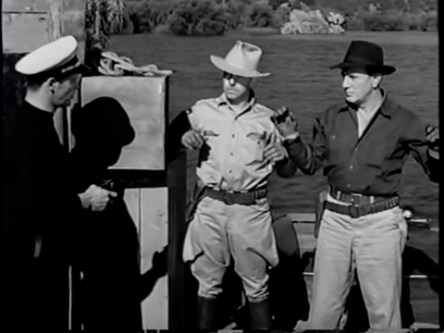
The most distinctive feature of Haunted Harbor is the location that gives the serial its name: the natives have stopped working to harvest copra* for the plantation (owned by Galbraith, the same man who owns the trading post Marsden manages), frightened off by demons and sea monsters. (The natives are mostly an abstraction, talked about more than seen, although one chapter takes place in the natives’ village.) It takes Marsden a while to get to the harbor to investigate for himself, but when he and Patricia take a boat out onto the water, the surface is disturbed by a horrible-looking sea serpent spouting steam from its nose. It sinks and pops back up in several locations, never attacking but looking menacing nonetheless. Marsden fires at it, but the bullets have no effect (his rifle had previously been loaded with blanks by Dranga, covertly working for Kane/Carter, but Marsden doesn’t know that). Real, honest-to-God monsters aren’t too common in the serials, especially those that aren’t otherwise science fiction, but the Haunted Harbor sea serpent is a memorable and well-designed creature, a candidate for a “deep cut” when discussing the sometimes quaint beasts that haunt old black and white movies. (The Lydecker brothers, Theodore credited and Howard uncredited, are responsible for the serial’s many effects shots, but I’m not sure if they actually designed the creature’s appearance.)
* the dried kernel of the coconut, from which oil can be extracted–see, I’m learning stuff from this!
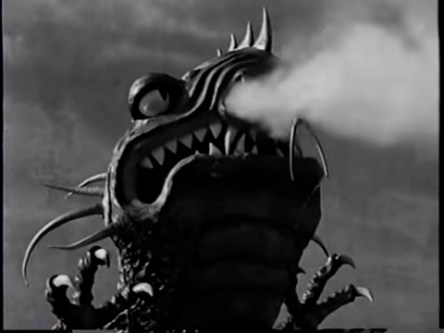
Other than appearing in title cards at the beginning of each chapter, the first glimpse the audience gets of the sea serpent is at the end of Chapter Five (“Harbor of Horror”), where its appearance and Marsden’s attempt to fight it form the cliffhanger, and then we don’t see it again until the last few chapters. It’s not hard to see why: as cool as the design is, the creature barely moves, its rigid expression frozen in place, relying on surprise and superstition to scare off the unwary rather than a real physical threat. As anyone who’s seen an episode of Scooby-Doo might guess, the sea serpents are fakes, mechanical monsters controlled from a remote switchboard and placed in the harbor to scare the natives away, allowing Kane/Carter to carry out his real scheme undisturbed. Although he doesn’t say so right away, Marsden clearly suspects this, but it isn’t until he can get a diving rig and crew to the harbor that he can prove it.

Like most of Republic’s output, Haunted Harbor goes down easily: it’s slick and entertaining, and the story is so straightforward that there’s not much risk of the audience getting confused. Transplanted to television, the narrative formulas established in serials like this would continue for decades (in particular, the “man on the run” aspect of this story foreshadows series like The Fugitive and The Incredible Hulk, and it is episodic enough that one could imagine it being much longer, stretching out Marsden’s search for Carter in order to clear his name). It’s worth noting that Haunted Harbor was based on a novel by “Dayle Douglas” (a pen name for screenwriter Ewart Adamson) and was the last direct serial adaptation Republic made (although there would be a few more Zorro titles, presumably original stories licensing the character).
What I Watched: Haunted Harbor (Republic, 1944)

Where I Watched It: A two-tape VHS set from Republic Pictures Home Video (The title card on the tape version actually calls it Pirates’ Harbor, the title under which Haunted Harbor was rereleased in 1951.)
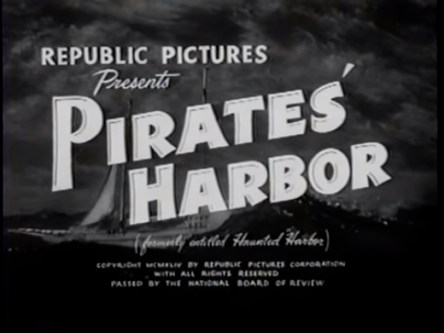
No. of Chapters: 15
Best Chapter Title: “Crucible of Justice” (Chapter Fifteen)

Best Cliffhanger: Republic in the mid-’40s seems to have rediscovered the element of sex appeal that had been toned down in some of their earlier serials. A “damsel in distress” bound, gagged, and in immediate mortal peril is a common shorthand for the serials, and while the ubiquity of this device is frequently exaggerated, there are nevertheless examples that justify the image. In Haunted Harbor, Patricia Harding is often on the receiving end of such treatment, nowhere more graphically than at the end of Chapter Nine, “Death’s Door.” In this chapter, Patricia has been abducted by Carter’s men and is held hostage in exchange for Dranga, whom they suppose to be injured and at risk of spilling Carter’s true identity. While the henchmen wait for Dranga to be delivered, they tie Patricia to a post in Kane’s mine and aim a powerful air drill at her, its trigger tied to the door so that if anyone enters the machine will fire its (loosened) bit through her skull. As in most cliffhangers, the threat is established, and then we are reminded of it via crosscutting between the outside room (where Marsden, having disguised himself as the actually deceased Dranga, is fighting it out with Carter’s henchmen) and Patricia at the post, quaking with fear, her eyes bulging. It’s a strong image, the kind of thing that makes an impression and looms larger in the memory than the more numerous prosaic scenes: no, women weren’t being tied up all the time in the serials, and this is just one cliffhanger out of many in this specific serial, but I can see why it tends to be remembered over other, less primal, scenes. (This was the era of Wonder Woman, after all.) Of course, once Marsden has finished mopping up the bad guys, he goes to the door and pulls it open: the air drill comes to life, and the bolt is fired. . . .

Best Resolution: At the beginning of the next chapter (“Crimson Sacrifice”), when Marsden opens that door, activating the air drill, Patricia simply ducks, sliding down the pillar so that the bit drives into the wood just above her head.
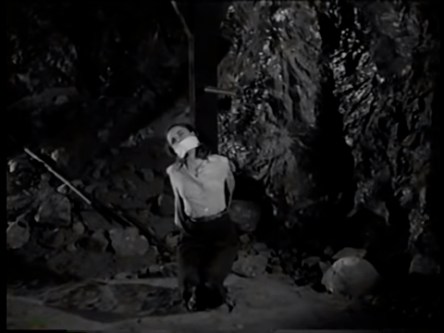
No offense, but that’s kind of anticlimactic. It means she wasn’t really tied that tightly in the first place, doesn’t it? My favorite resolutions tend to display the characters’ (and writers’) ingenuity in finding surprising ways out, but this is a bit of a shrug. In any case, as the story continues, Marsden gets into trouble for presenting the chief of the natives with a radio, a radio that has been hooked up with an explosive by Carter’s men so that it will take out the chief and make Marsden look bad. Sure enough, after the explosion of the chief’s hut, Marsden is accused of witchcraft (“You brought the devil box here to slay our chief!”) and immediately seized; in no time at all, he’s been tied to a platform suspended over a raging funeral pyre. The chapter ends with the flames surrounding him and the platform collapsing into the bonfire.
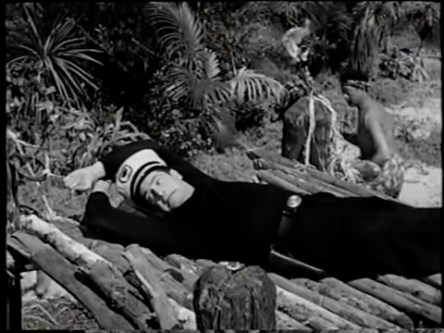
But wait! As resolved in the next chapter (“Jungle Jeopardy”), Patricia, who has been forced to stand by and watch, grabs a gun from her captors and shoots the ropes that bind Marsden (through a wall of flames and at a distance, the kind of one-in-a-million shot that serial heroes routinely make), then covering his captors so that they can both escape. Now, that’s more like it.

Sample Dialogue: “Haunted Harbor certainly seems quiet and peaceful enough. . . . A sea serpent!” –Patricia Harding, Chapter Five (“Harbor of Horror”)

What Others Have Said: “[Roy] Barcroft played many minor parts in serials until 1944. That year he took the lead villain’s role in Haunted Harbor at Republic, and launched an amazing career. For the next ten years, he played a succession of bad guys probably unequalled by any other actor in the field–pirate, outlaw, gangster, crooked cop, spaceman, renegade, crooked sheriff, saloon keeper, politician–you name it. He was Republic’s top villain for those ten years, and the man the fans ‘loved to hate.'” –William C. Cline, “Good at Being Bad” from Serials-ly Speaking

What’s Next: I’m taking a slight detour from my “summer of VHS” to examine a late Universal serial, Lost City of the Jungle!